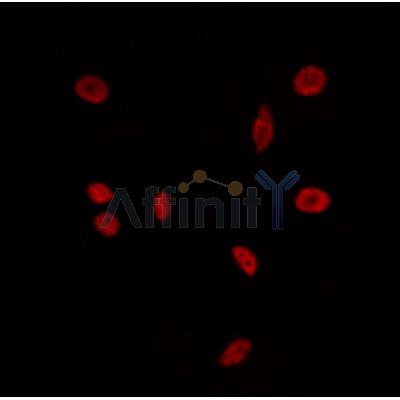BAZ2A Antibody - #DF3858
| Product: | BAZ2A Antibody |
| Catalog: | DF3858 |
| Description: | Rabbit polyclonal antibody to BAZ2A |
| Application: | WB IF/ICC |
| Reactivity: | Human |
| Prediction: | Pig, Zebrafish, Bovine, Horse, Sheep, Rabbit, Dog |
| Mol.Wt.: | 210 KD; 211kD(Calculated). |
| Uniprot: | Q9UIF9 |
| RRID: | AB_2836215 |
Related Downloads
Protocols
Product Info
*The optimal dilutions should be determined by the end user. For optimal experimental results, antibody reuse is not recommended.
*Tips:
WB: For western blot detection of denatured protein samples. IHC: For immunohistochemical detection of paraffin sections (IHC-p) or frozen sections (IHC-f) of tissue samples. IF/ICC: For immunofluorescence detection of cell samples. ELISA(peptide): For ELISA detection of antigenic peptide.
Cite Format: Affinity Biosciences Cat# DF3858, RRID:AB_2836215.
Immunogens
A synthesized peptide derived from human BAZ2A, corresponding to a region within N-terminal amino acids.
Expressed at moderate levels in most tissues analyzed, including heart, brain, placenta, lung, skeletal muscle, kidney and pancreas.
- Q9UIF9 BAZ2A_HUMAN:
- Protein BLAST With
- NCBI/
- ExPASy/
- Uniprot
MEMEANDHFNFTGLPPAPAASGLKPSPSSGEGLYTNGSPMNFPQQGKSLNGDVNVNGLSTVSHTTTSGILNSAPHSSSTSHLHHPSVAYDCLWNYSQYPSANPGSNLKDPPLLSQFSGGQYPLNGILGGSRQPSSPSHNTNLRAGSQEFWANGTQSPMGLNFDSQELYDSFPDQNFEVMPNGPPSFFTSPQTSPMLGSSIQTFAPSQEVGSGIHPDEAAEKEMTSVVAENGTGLVGSLELEEEQPELKMCGYNGSVPSVESLHQEVSVLVPDPTVSCLDDPSHLPDQLEDTPILSEDSLEPFNSLAPEPVSGGLYGIDDTELMGAEDKLPLEDSPVISALDCPSLNNATAFSLLADDSQTSTSIFASPTSPPVLGESVLQDNSFDLNNGSDAEQEEMETQSSDFPPSLTQPAPDQSSTIQLHPATSPAVSPTTSPAVSLVVSPAASPEISPEVCPAASTVVSPAVFSVVSPASSAVLPAVSLEVPLTASVTSPKASPVTSPAAAFPTASPANKDVSSFLETTADVEEITGEGLTASGSGDVMRRRIATPEEVRLPLQHGWRREVRIKKGSHRWQGETWYYGPCGKRMKQFPEVIKYLSRNVVHSVRREHFSFSPRMPVGDFFEERDTPEGLQWVQLSAEEIPSRIQAITGKRGRPRNTEKAKTKEVPKVKRGRGRPPKVKITELLNKTDNRPLKKLEAQETLNEEDKAKIAKSKKKMRQKVQRGECQTTIQGQARNKRKQETKSLKQKEAKKKSKAEKEKGKTKQEKLKEKVKREKKEKVKMKEKEEVTKAKPACKADKTLATQRRLEERQRQQMILEEMKKPTEDMCLTDHQPLPDFSRVPGLTLPSGAFSDCLTIVEFLHSFGKVLGFDPAKDVPSLGVLQEGLLCQGDSLGEVQDLLVRLLKAALHDPGFPSYCQSLKILGEKVSEIPLTRDNVSEILRCFLMAYGVEPALCDRLRTQPFQAQPPQQKAAVLAFLVHELNGSTLIINEIDKTLESMSSYRKNKWIVEGRLRRLKTVLAKRTGRSEVEMEGPEECLGRRRSSRIMEETSGMEEEEEEESIAAVPGRRGRRDGEVDATASSIPELERQIEKLSKRQLFFRKKLLHSSQMLRAVSLGQDRYRRRYWVLPYLAGIFVEGTEGNLVPEEVIKKETDSLKVAAHASLNPALFSMKMELAGSNTTASSPARARGRPRKTKPGSMQPRHLKSPVRGQDSEQPQAQLQPEAQLHAPAQPQPQLQLQLQSHKGFLEQEGSPLSLGQSQHDLSQSAFLSWLSQTQSHSSLLSSSVLTPDSSPGKLDPAPSQPPEEPEPDEAESSPDPQALWFNISAQMPCNAAPTPPPAVSEDQPTPSPQQLASSKPMNRPSAANPCSPVQFSSTPLAGLAPKRRAGDPGEMPQSPTGLGQPKRRGRPPSKFFKQMEQRYLTQLTAQPVPPEMCSGWWWIRDPEMLDAMLKALHPRGIREKALHKHLNKHRDFLQEVCLRPSADPIFEPRQLPAFQEGIMSWSPKEKTYETDLAVLQWVEELEQRVIMSDLQIRGWTCPSPDSTREDLAYCEHLSDSQEDITWRGRGREGLAPQRKTTNPLDLAVMRLAALEQNVERRYLREPLWPTHEVVLEKALLSTPNGAPEGTTTEISYEITPRIRVWRQTLERCRSAAQVCLCLGQLERSIAWEKSVNKVTCLVCRKGDNDEFLLLCDGCDRGCHIYCHRPKMEAVPEGDWFCTVCLAQQVEGEFTQKPGFPKRGQKRKSGYSLNFSEGDGRRRRVLLRGRESPAAGPRYSEEGLSPSKRRRLSMRNHHSDLTFCEIILMEMESHDAAWPFLEPVNPRLVSGYRRIIKNPMDFSTMRERLLRGGYTSSEEFAADALLVFDNCQTFNEDDSEVGKAGHIMRRFFESRWEEFYQGKQANL
Predictions
Score>80(red) has high confidence and is suggested to be used for WB detection. *The prediction model is mainly based on the alignment of immunogen sequences, the results are for reference only, not as the basis of quality assurance.
High(score>80) Medium(80>score>50) Low(score<50) No confidence
Research Backgrounds
Essential component of the NoRC (nucleolar remodeling complex) complex, a complex that mediates silencing of a fraction of rDNA by recruiting histone-modifying enzymes and DNA methyltransferases, leading to heterochromatin formation and transcriptional silencing. In the complex, it plays a central role by being recruited to rDNA and by targeting chromatin modifying enzymes such as HDAC1, leading to repress RNA polymerase I transcription. Recruited to rDNA via its interaction with TTF1 and its ability to recognize and bind histone H4 acetylated on 'Lys-16' (H4K16ac), leading to deacetylation of H4K5ac, H4K8ac, H4K12ac but not H4K16ac. Specifically binds pRNAs, 150-250 nucleotide RNAs that are complementary in sequence to the rDNA promoter; pRNA-binding is required for heterochromatin formation and rDNA silencing (By similarity).
Acetylation at Lys-680 by KAT8/MOF promotes its dissociation from pRNA, affecting heterochromatin formation, nucleosome positioning and rDNA silencing. Deacetylation by SIRT1 in late S phase enhances pRNA-binding, allowing de novo DNA methylation and heterochromatin formation. Acetylation is high during S phase and declines to background levels in late S phase when the silent copies of rRNA genes are replicated (By similarity).
Ubiquitinated. Deubiquitinated by USP21 leading to its stabilization.
Nucleus>Nucleolus.
Note: Colocalizes with the basal RNA polymerase I transcription factor UBF in the nucleolus.
Expressed at moderate levels in most tissues analyzed, including heart, brain, placenta, lung, skeletal muscle, kidney and pancreas.
The bromo domain and the PHD-type zinc finger recognize and bind histone H4 acetylated on 'Lys-16' (H4K16ac). These 2 domains play a central role in the recruitment of chromatin silencing proteins such as DNMT1, DNMT3B and HDAC1.
The MBD (methyl-CpG-binding) domain, also named TAM domain, specifically recognizes and binds a conserved stem-loop structure the association within pRNA. Binding to pRNA induces a conformational change of BAZ2A/TIP5 and is essential for targeting the NoRC complex to the nucleolus (By similarity).
Belongs to the WAL family.
References
Restrictive clause
Affinity Biosciences tests all products strictly. Citations are provided as a resource for additional applications that have not been validated by Affinity Biosciences. Please choose the appropriate format for each application and consult Materials and Methods sections for additional details about the use of any product in these publications.
For Research Use Only.
Not for use in diagnostic or therapeutic procedures. Not for resale. Not for distribution without written consent. Affinity Biosciences will not be held responsible for patent infringement or other violations that may occur with the use of our products. Affinity Biosciences, Affinity Biosciences Logo and all other trademarks are the property of Affinity Biosciences LTD.

